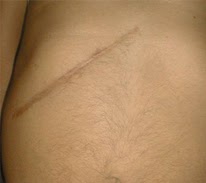Introduction
Gallstones are
small stones, usually made of cholesterol, that form in the gallbladder. In
most cases they do not cause any symptoms and do not need to be treated.
However, if a
gallstone becomes trapped in a duct (opening) inside the gallbladder it can
trigger a sudden intense abdominal pain that usually lasts between one and five
hours. This type of abdominal pain is known as biliary colic.
The medical term
for symptoms and complications related to gallstones is gallstone disease or cholelithiasis.
Gallstone
disease can also cause inflammation of the gallbladder (cholecystitis).
This can cause persistent pain, jaundice and a high temperature (fever) of 38°C or above.
In some cases, a
gallstone can move into the pancreas, causing it to become irritated and
inflamed. This is known as acute pancreatitis and causes abdominal pain that gets progressively
worse, and sometimes life threatening.
The
gallbladder
The gallbladder
is a small, pouch-like organ situated underneath the liver. The main purpose of
the gallbladder is to store and concentrate bile.
Bile is a liquid
produced by the liver, which helps digest fats. It is passed from the liver
through a series of channels, known as bile ducts, into the gallbladder.
The bile is
stored in the gallbladder and over time it becomes more concentrated, which
makes it better at digesting fats. The gallbladder is able to release bile into
the digestive system when it is needed.
What
causes gallstones
It is thought
that gallstones develop because of an imbalance in the chemical make-up of bile
inside the gallbladder. In most cases the levels of cholesterol in bile become
too high and the excess cholesterol forms into stones.
Gallstones are
very common. It is estimated that more than one in every 10 adults has
gallstones, although only a minority of people will develop
symptoms.
Gallstones are particularly
more common in the following groups:
•women, particularly those who have had
children
•overweight or obese people – people who
are overweight with a body mass index (BMI) of 25 or above
•people aged 40 years or older (the
older you are, the more likely you are to develop gallstones)
•people with cirrhosis (scarring of the liver)
•people with the
digestive disorders Crohn’s disease
and irritable bowel syndrome (IBS)
• patient with haemolytic blood disorders
•people with a family history of gallstones (around a
third of people with gallstones have a close family member who has also had
gallstones)
•people who have
recently lost weight, either as a
result of dieting or weight-loss surgery such as gastric banding, gastric bypass or sleeve gastrectomy.
•people who are
taking a medication called ceftriaxone,
which is an antibiotic used to treat a range of infections, including
pneumonia, meningitis and gonorrhoea
What Are the
Symptoms of Gallstones?
Gallstones often
don't cause symptoms. Those that don't are called "silent stones." A
person usually learns he or she has gallstones while being examined for another
illness.
When symptoms do
appear, they may include:
- Pain in the upper abdomen and upper back;
the pain may last for several hours.
- Nausea
- Vomiting
- Other gastrointestinal problems, including
bloating, indigestion and heartburn, and gas
How
Are Gallstones Diagnosed?
If your doctor
suspects you have gallstones, he or she will do a physical exam and may perform
various other tests, including the following:
- Blood tests: Blood
tests may be given to check for signs of infection or obstruction and/or
to rule out other conditions.
- Ultrasound: This
procedure produces images of various parts of the body and can be used to
identify gallstones.
- CAT scan: This
test uses specialized X-rays to create cross-section images of organs and
body tissues.
- Magnetic resonance cholangiopancreatography (MRCP): This test uses a magnetic field and pulses of radio
wave energy to get pictures of structures inside the body, including the
liver and the gallbladder.
- Endoscopic ultrasound: This test combines ultrasound and endoscopy to look for
gallstones.
- Endoscopic retrograde
cholangiopancreatography (ERCP): The doctor inserts an
endoscope through the patient's mouth down to the small intestine and
injects a dye to allow the bile ducts to be seen. The doctor can often
then remove any gallstones that have moved into the duct
Treatment is
usually only necessary if gallstones are causing symptoms, such as abdominal
pain, infections or acute pancreatitis.
In these cases,
keyhole surgery to remove the gallbladder may be recommended. This
procedure, known as a laparoscopic cholecystectomy, is relatively simple to perform and has a low
risk of complications.
During this
procedure, instruments, a light, and a camera are passed through several small
incisions in the abdomen. The surgeon views the inside of the body by looking
at a video monitor. This procedure is used in of the majority of gallbladder
removals. After the surgery, the patient spends the night in the hospital, or
sometimes patient can be allowed home on the same day.
You can lead a
perfectly normal life without a
gallbladder. The organ can be useful but it is not essential. Your liver will
still produce bile to digest food, but the bile will just drip
continuously into the small intestine, rather than build up in the
gallbladder.
Outlook
Most cases of
gallstone disease are easily treated with surgery. Very severe cases can
be life-threatening, especially in people who are already in poor health, but
deaths are rare.
 |
| Open cholecystectomy wound |
 |
| "keyhole" cholecystectomy wound |











No comments:
Post a Comment